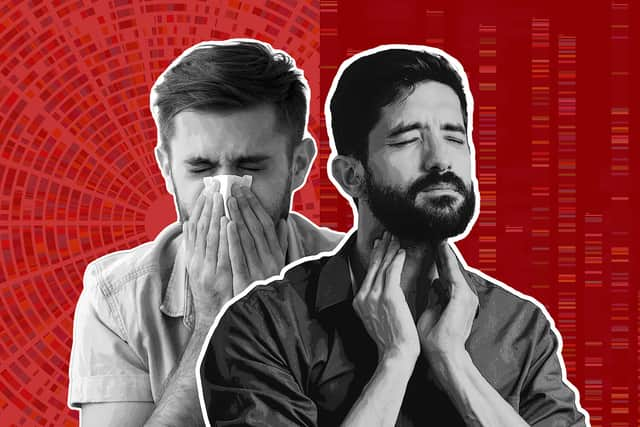Covid symptoms: ‘main indicator’ of virus that shouldn’t be mistaken for a cold
and live on Freeview channel 276
Health experts have warned of a ‘telltale’ symptom of Covid that should not be mistaken for a common cold.
The ZOE Health Study tracks symptoms that are reported by users of its Covid app across the UK to monitor the top signs of infection at the moment. In its latest update, one symptom was identified as a “main indicator” of the virus, which is much less common in colds.
Advertisement
Hide AdAdvertisement
Hide AdZOE’s Chief Scientist Dr Sarah Berry said a sore throat is currently the most commonly reported Covid symptom, but urged people to look out for a “scratchy throat” specifically.
Dr Berry said: “Our top symptoms at the moment are sore throat, blocked nose, headache, and runny nose. We’ve not actually seen any change as a result of any new variants, and that’s mainly because they’re still really rare at the moment. However, we will continue to monitor these and note any shifts or changes for you to look out for.
“Currently the symptoms actually remain very similar to a cold or any other respiratory illness, but we have found that the main indicator of Covid tends to be a scratchy sore throat which is not as common in colds.”


It comes after Professor Spector, lead scientist on the ZOE Health Study, explained in a previous update that symptoms of a cold and Covid are very similar, but there are some ways to tell them apart.
Advertisement
Hide AdAdvertisement
Hide AdProf Spector advised: “In a cold, you are more likely to have a runny nose than for Covid and you are also more likely to be having sneezing, which again is less frequent with Covid. But it is pretty hard to tell and you just need to get yourself tested.”
Data suggests those who are unvaccinated may be more likely to get a headache and a sore throat as a key indicator of Covid, whereas a runny nose tops the list of symptoms among those who are fully vaccinated.
What are the top Covid symptoms right now?
The following symptoms are currently the most common signs of Covid infection, according to the ZOE Health Study:
- Sore throat
- Blocked nose
- Headache
- Cough (no phlegm)
- Runny nose
- Sneezing
- Cough (with phlegm)
- Hoarse voice
- Muscle pains and aches
- Fatigue
- Dizzy
- Altered smell
- Swollen neck glands
- Chest pain and tightness
- Shortness of breath
- Eye soreness
- Loss of smell
- Earache
- Chills or shivers
- Joint pain (shoulders)
Are Covid infections still rising?
Covid infections have fallen in all four nations of the UK for the first time in almost three months, new figures show.
Advertisement
Hide AdAdvertisement
Hide AdThe total number of people in private households in the UK testing positive for the virus stood at 1.5 million in the week to 1 November - down 18% from 1.9 million in the previous week, according to the Office for National Statistics (ONS).
The figures suggest that the current wave of the virus has peaked after reaching just over two million infections in mid-October - far below the peak of nearly four million in early July.
A mix of Omicron variants have been driving the latest wave, all of which are being monitored for their potential to spread rapidly, but as yet none have been designated variants of concern.
Hospital numbers are also continuing to fall across the country, with health experts praising the autumn booster campaign for helping to prevent high levels of serious illness.
Advertisement
Hide AdAdvertisement
Hide AdSarah Crofts, ONS deputy director for the Covid-19 infection survey, said the new figures showed the picture across the UK was “generally a positive one”, with infections falling in every nation for the first time 10 weeks.
She said: “Infections have decreased in all age groups in England, including the over-70s, which are still among the highest infected.
“There was also a decrease in infections among these older ages in Wales, though the trend is uncertain in Scotland and Northern Ireland. We will continue to monitor the data as we move through winter.”
Comment Guidelines
National World encourages reader discussion on our stories. User feedback, insights and back-and-forth exchanges add a rich layer of context to reporting. Please review our Community Guidelines before commenting.
